-
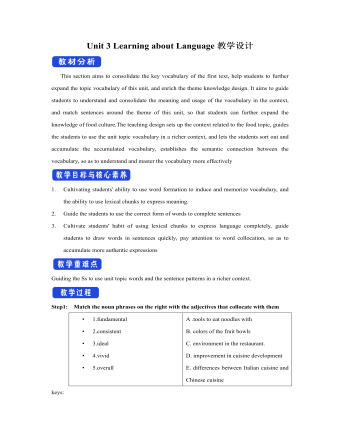
新人教版高中英语选修2Unit 3 Learning about Language教学设计
1. We'll need ten months at least to have the restaurant decorated.2.Some traditional Chinese dishes from before the Ming Dynasty are still popular today.3.My grandpa's breakfast mainly includes whole grain biscuits and a glass of milk.4.People in this area would eat nearly a kilo of cheese per week.5. We enjoyed a special dinner in a fancy restaurant where the waiters all wore attractive suits.6. He prefers this brand of coffee which, as he said, has an unusually good flavor.Key:1. at a minimum 2. prior to3. consist of4. consume5. elegant6. exceptionalStep 5:Familiarize yourself with some food idioms by matching the meaning on the right with the colored words on the left.1.Public concern for the health of farm animals has mushroomed in the UK2.Anderson may be young but he's certainly rolling to doing dough!3.George is a popular lecturer. He often peppers his speech with jokes.4.As the person to bring home the bacon, he needs to find a stable job.5 He is often regarded as a ham actor for his over emphasized facial expressions. The media reported that these companies had treated pollution as a hot potato. 6.The media reported that these companies had treated pollution as a hot potato.7.Don't worry about the test tomorrow. It's going to be a piece of cake!8. It's best to fold the swimming ring when it is as flat as a pancake.A. completely flatB. something that is very easy to do C.an issue that is hard to deal withD.to include large numbers of somethingE.to earn on e's living to support a familyF. wealthyG.to rapidly increase in numberH. an actor who performs badly, especially by over emphasizing emotions
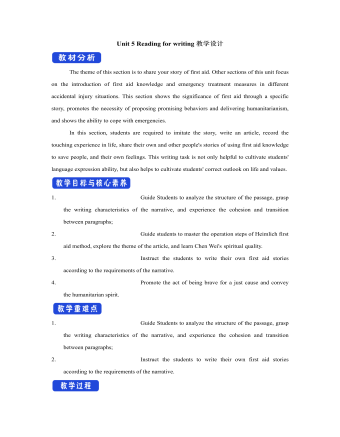
新人教版高中英语选修2Unit 5 Reading for writing教学设计
你校英语报计划出版一期急救常识专刊,现面向全校学生公开征集稿件,你有意参加。请你根据下面提示内容,用英语写一篇短文,介绍在车祸现场对伤者进行急救的方法和步骤。1.确保现场的安全;2.询问伤者,确保其呼吸正常;3.检查伤口,如流血则应采取止血措施;4.如需急救,确保其处于康复位置。注意:1.词数80左右;2.可以适当增加细节,以使行文连贯。参考词汇:康复位置 recovery positionAs we all know, having a knowledge of first aid can make a great difference in our daily life. If a traffic accident happens and someone is injured, the following steps can be used to treat the injured.In the first place, we should make sure that the accident scene is safe so that we won’t get hurt. We should ask the injured person if he is OK, and see if he is breathing. What’s more, we should check for cuts and wounds. If he is bleeding badly, it is vital that we should try to stop the bleeding by applying pressure to the injury. This is because if a person loses too much blood, he may die. If necessary, take the injured person to the hospital as soon as possible.Do remember: when giving first aid, please be sure to place the person in a recovery position.
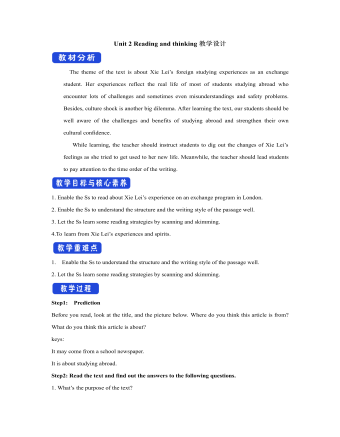
新人教版高中英语选修2Unit 2 Reading and thinking教学设计
Her tutor told her to acknowledge __________ other people had said if she cited their ideas, and advised her _______(read) lots of information in order to form __________wise opinion of her own.Now halfway __________ her exchange year, Xie Lei felt much more at home in the UK. She said __________ (engage) in British culture had helped and that she had been__________ (involve) in social activities. She also said while learning about business, she was acting as a cultural messenger __________(build) a bridge between the two countries. keys:Xie Lei, a 19yearold Chinese student, said goodbye to her family and friends in China and boarded (board) a plane for London six months ago in order to get a business qualification. She was ambitious(ambition) to set up a business after graduation. It was the first time that she had left (leave) home.At first, Xie Lei had to adapt to life in a different country. She chose to live with a host family, who can help with her adaptation (adapt) to the new culture. When she missed home, she felt comforted (comfort) to have a second family. Also Xie Lei had to satisfy academic requirements. Her tutor told her to acknowledge what other people had said if she cited their ideas, and advised her to read lots of information in order to form a wise opinion of her own.Now halfway through her exchange year, Xie Lei felt much more at home in the UK. She said engaging (engage) in British culture had helped and that she had been involved (involve) in social activities. She also said while learning about business, she was acting as a cultural messenger building a bridge between the two countries.
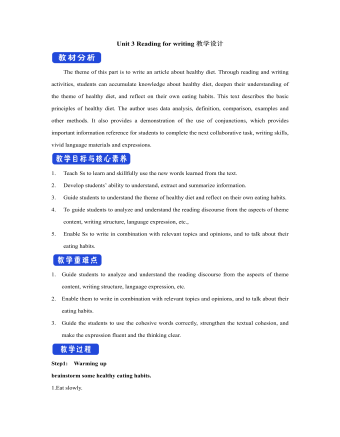
新人教版高中英语选修2Unit 3 Reading for writing教学设计
The theme of this part is to write an article about healthy diet. Through reading and writing activities, students can accumulate knowledge about healthy diet, deepen their understanding of the theme of healthy diet, and reflect on their own eating habits. This text describes the basic principles of healthy diet. The author uses data analysis, definition, comparison, examples and other methods. It also provides a demonstration of the use of conjunctions, which provides important information reference for students to complete the next collaborative task, writing skills, vivid language materials and expressions.1. Teach Ss to learn and skillfully use the new words learned from the text.2. Develop students’ ability to understand, extract and summarize information.3. Guide students to understand the theme of healthy diet and reflect on their own eating habits.4. To guide students to analyze and understand the reading discourse from the aspects of theme content, writing structure, language expression, etc., 5. Enable Ss to write in combination with relevant topics and opinions, and to talk about their eating habits.1. Guide students to analyze and understand the reading discourse from the aspects of theme content, writing structure, language expression, etc.2. Enable them to write in combination with relevant topics and opinions, and to talk about their eating habits.3. Guide the students to use the cohesive words correctly, strengthen the textual cohesion, and make the expression fluent and the thinking clear.Step1: Warming upbrainstorm some healthy eating habits.1.Eat slowly.2.Don’t eat too much fat or sugar.3.Eat healthy food.4.Have a balanced diet.Step2: Read the passage and then sum up the main idea of each paragraph.
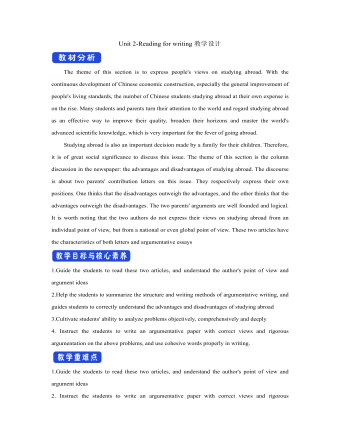
新人教版高中英语选修2Unit 2 Reading for writing教学设计
The theme of this section is to express people's views on studying abroad. With the continuous development of Chinese economic construction, especially the general improvement of people's living standards, the number of Chinese students studying abroad at their own expense is on the rise. Many students and parents turn their attention to the world and regard studying abroad as an effective way to improve their quality, broaden their horizons and master the world's advanced scientific knowledge, which is very important for the fever of going abroad. Studying abroad is also an important decision made by a family for their children. Therefore, it is of great social significance to discuss this issue. The theme of this section is the column discussion in the newspaper: the advantages and disadvantages of studying abroad. The discourse is about two parents' contribution letters on this issue. They respectively express their own positions. One thinks that the disadvantages outweigh the advantages, and the other thinks that the advantages outweigh the disadvantages. The two parents' arguments are well founded and logical. It is worth noting that the two authors do not express their views on studying abroad from an individual point of view, but from a national or even global point of view. These two articles have the characteristics of both letters and argumentative essays1.Guide the students to read these two articles, and understand the author's point of view and argument ideas2.Help the students to summarize the structure and writing methods of argumentative writing, and guides students to correctly understand the advantages and disadvantages of studying abroad3.Cultivate students' ability to analyze problems objectively, comprehensively and deeply

新人教版高中英语选修2Unit 3 Using langauge-Listening教学设计
1. How is Hunan cuisine somewhat different from Sichuan cuisine?The heat in Sichuan cuisine comes from chilies and Sichuan peppercorns. Human cuisine is often hotter and the heat comes from just chilies.2.What are the reasons why Hunan people like spicy food?Because they are a bold people. But many Chinese people think that hot food helps them overcome the effects of rainy or wet weather.3.Why do so many people love steamed fish head covered with chilies?People love it because the meat is quite tender and there are very few small bones.4.Why does Tingting recommend bridge tofu instead of dry pot duck with golden buns?Because bridge tofu has a lighter taste.5 .Why is red braised pork the most famous dish?Because Chairman Mao was from Hunan, and this was his favorite food.Step 5: Instruct students to make a short presentation to the class about your choice. Use the example and useful phrases below to help them.? In groups of three, discuss what types of restaurant you would like to take a foreign visitor to, and why. Then take turns role-playing taking your foreign guest to the restaurant you have chosen. One of you should act as the foreign guest, one as the Chinese host, and one as the waiter or waitress. You may start like this:? EXAMPLE? A: I really love spicy food, so what dish would you recommend?? B: I suggest Mapo tofu.? A: Really ? what's that?

新人教版高中英语选修2Unit 4 Learning about Language教学设计
This section guides students to pay attention to the typical context of vocabulary use, helps students accumulate vocabulary around the key vocabulary of this unit, and uses the learned words and word chunks in different contexts to deeply understand their meaning and usage, so as to achieve the purpose of review and consolidation.The teaching design activities aim to guide students to pay attention to the typical context in which the target vocabulary is used, as well as the common vocabulary used in collocation, so that students can complete the sentence with correct words. In terms of vocabulary learning strategies, this unit focuses on cultivating students' ability to pay attention to collocation of words and to use word blocks to express meaning.For vocabulary learning, it is not enough just to know the meaning of a single word, but the most important thing is to master the common collocations of words, namely word blocks.Teachers should timely guide students to summarize common vocabulary collocation, such as verb and noun collocation, verb and preposition collocation, preposition and noun collocation, and so on.1. Guide students to understand and consolidate the meaning and usage of the vocabulary in the context, 2. Guide the students to use the unit topic vocabulary in a richer context3. Let the students sort out and accumulate the accumulated vocabulary, establishes the semantic connection between the vocabulary,4. Enable students to understand and master the vocabulary more effectivelyGuiding the Ss to use unit topic words and the sentence patterns in a richer context.

新人教版高中英语选修2Unit 4 Reading for writing教学设计
假定你是英国的Jack,打算来中国旅行,请你给你的中国笔友李华写一封信,要点如下:1.你的旅行计划:北京→泰山→杭州;2.征求建议并询问他是否愿意充当你的导游。注意:1.词数80左右(开头和结尾已给出,不计入总词数);2.可以适当增加细节,以使行文连贯。参考词汇:故宫 the Forbidden City;泰山 Mount TaiDear Li Hua,I'm glad to tell you that 'm going to visit China.First,I am planning to visit Beijing,the capitalof China,where I am looking forward to enjoying the Great Wall,the Forbidden City and somebeautiful parks.Then I intend to go to visit Mount Tai in Shandong Province.I've heard that it is one ofthe most famous mountains in China and I can't wait to enjoy the amazing sunrise there.After that,I amalso going to Hangzhou.It is said that it is a beautiful modern city with breathtaking natural sights,among which the West Lake is a well- known tourist attraction.What do you think of my travel plan? Will you act as my guide? Hope to hear from you soon.

新人教版高中英语选修2Unit 4 Using langauge-Listening教学设计
The theme of the listening section is " talking about scenery and culture along a journey."The part is designed to further lead the students to understand Canadian natural geography and social environment, and integrated into the cultural contrast by mentioning the long train journey from Beijing to Moscow routes. On this basis, the part activates students related travel experience, lets the student serial dialogue, guides the student to explore further the pleasure and meaning of the long journey, and Chinese and foreign cultural comparison.The part also provides a framework for the continuation of the dialogue, which is designed to provide a framework for students to successfully complete their oral expressions, and to incorporate an important trading strategy to end the dialogue naturally.1. Help students to understand and master some common English idioms in the context, and experience the expression effect of English idioms.2. Guide the students to understand the identity of different people in the listening context, and finish the dialogue according to their own experience.3. Instruct the students to use appropriate language to express surprise and curiosity about space and place in the dialogue, and master the oral strategy of ending the dialogue naturally.1. Instruct students to grasp the key information and important details of the dialogue.2. Instruct students to conduct a similar talk on the relevant topic.

新人教版高中英语选修2Unit 5 Learning about Language教学设计
The purpose of this section of vocabulary exercises is to consolidate the key words in the first part of the reading text, let the students write the words according to the English definition, and focus on the detection of the meaning and spelling of the new words. The teaching design includes use English definition to explain words, which is conducive to improving students' interest in vocabulary learning, cultivating their sense of English language and thinking in English, and making students willing to use this method to better grasp the meaning of words, expand their vocabulary, and improve their ability of vocabulary application. Besides, the design offers more context including sentences and short passage for students to practice words flexibly.1. Guide students to understand and consolidate the meaning and usage of the vocabulary in the context, 2. Guide the students to use the unit topic vocabulary in a richer context3. Let the students sort out and accumulate the accumulated vocabulary, establishes the semantic connection between the vocabulary,4. Enable students to understand and master the vocabulary more effectivelyGuiding the Ss to use unit topic words and the sentence patterns in a richer context.Step1: Read the passage about chemical burns and fill in the blanks with the correct forms of the words in the box.

新人教版高中英语选修2Unit 5 Reading and thinking教学设计
The theme of this activity is to learn the first aid knowledge of burns. Burns is common in life, but there are some misunderstandings in manual treatment. This activity provides students with correct first aid methods, so as not to take them for granted in an emergency. This section guides students to analyze the causes of scald and help students avoid such things. From the perspective of text structure and collaborative features, the text is expository. Expository, with explanation as the main way of expression, transmits knowledge and information to readers by analyzing concepts and elaborating examples. This text arranges the information in logical order, clearly presents three parts of the content through the subtitle, accurately describes the causes, types, characteristics and first aid measures of burns, and some paragraphs use topic sentences to summarize the main idea, and the level is very clear.1. Guide students to understand the causes, types, characteristics and first aid methods of burns, through reading2. Enhance students’ ability to deal withburnss and their awareness of burns prevention3. Enable students to improve the ability to judge the types of texts accurately and to master the characteristics and writing techniques of expository texts.Guide students to understand the causes, types, characteristics and first aid methods of burns, through readingStep1: Lead in by discussing the related topic:1. What first-aid techniques do you know of ?CPR; mouth to mouth artificial respiration; the Heimlich Manoeuvre

新人教版高中英语选修2Unit 5 Using langauge-Listening教学设计
The theme of this section is to learn how to make emergency calls. Students should learn how to make emergency calls not only in China, but also in foreign countries in English, so that they can be prepared for future situations outside the home.The emergency telephone number is a vital hotline, which should be the most clear, rapid and effective communication with the acute operator.This section helps students to understand the emergency calls in some countries and the precautions for making emergency calls. Through the study of this section, students can accumulate common expressions and sentence patterns in this context. 1.Help students accumulate emergency telephone numbers in different countries and learn more about first aid2.Guide the students to understand the contents and instructions of the telephone, grasp the characteristics of the emergency telephone and the requirements of the emergency telephone.3.Guide students to understand the first aid instructions of the operators.4.Enable Ss to make simulated emergency calls with their partners in the language they have learned1. Instruct students to grasp the key information and important details of the dialogue.2. Instruct students to conduct a similar talk on the relevant topic.Step1:Look and discuss:Match the pictures below to the medical emergencies, and then discuss the questions in groups.

部编人教版三年级下册《习作七 国宝大熊猫》说课稿
一、说教材本单元习作的话题是"国宝熊猫",引导学生根据问题查找信息并尝试学习整合有关信息。熊猫教材编排了三个部分内容,第一部分教材首先提供了关于大熊猫许多小朋友都想了解的三个问题,使得本次习作具有更强的针对性,教材呈现的三个问题,有的指向熊猫的,有的指向熊猫的生活的地方,而熊猫为什么被视为"中国的国宝",则指向熊猫的价值,他们只是问题罗列,是小朋友可能提出问题的一部分,其作用是让学生从这些问题受到启发,打开思路继续提出自己有兴趣的问题,第二部分首先明确了本次习作的任务就是围绕这个话题介绍一下熊猫,为介绍大熊猫奠定了基础。二、说教学目标1、针对教材提出的问题,搜集国宝大熊猫的相关资料信息。2、初步学习整合信息,从不同方面介绍国宝大熊猫。3、走进国宝大熊猫,学习整合信息,从不同方面了解大能猫。三、说教学重难点教学重点∶初步学习整合大熊猫的信息,结合资料,从自己感兴趣的方面介绍国宝大熊猫。教学难点∶利用搜集的信息,按一定的顺序准确地介绍大熊猫。
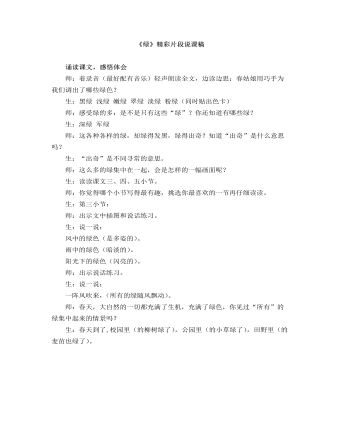
部编人教版四年级下册《绿》精彩片段说课稿
诵读课文,感悟体会师:着录音(最好配有音乐)轻声朗读全文,边读边思:春姑娘用巧手为我们调出了哪些绿色?生:黑绿 浅绿 嫩绿 翠绿 淡绿 粉绿(同时贴出色卡)师:感受绿的多:是不是只有这些“绿”?你还知道有哪些绿? 生:深绿 军绿 师:这各种各样的绿,却绿得发黑,绿得出奇?知道“出奇”是什么意思吗?生:“出奇”是不同寻常的意思。师:这么多的绿集中在一起,会是怎样的一幅画面呢?生:读读课文三、四、五小节。
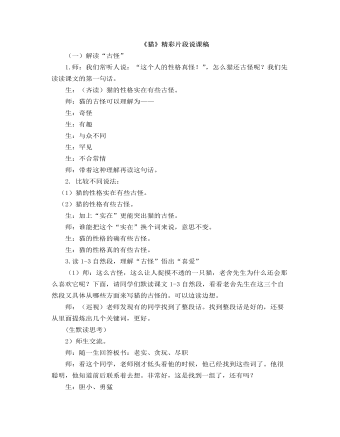
部编人教版四年级下册《猫》精彩片段说课稿
师:在幼儿园的时候,老师摸着小朋友的头说:“小朋友,乖——”回到家的时候,爷爷奶奶亲孙子,亲的了不得了:“宝贝儿,乖——”那现在,老舍先生说猫乖,你怎么看。生:老舍先生对猫的喜爱。师:那好,把你体会到的这个词写到上面来。(师指引学生把“乖”写在“勇猛”的右下角)同学们,这是我们读书读出来的。同学们,是不是我们这样去读句子,这样去读书,就更进一步了呢?这是有关“老实”的,你能不能再找找“贪玩”的有关句子?生:它要出去玩,一天一夜,任凭谁怎么呼唤也不回来。师:“任凭谁怎么呼唤,它也不肯回来”,想想看,老舍先生的家里,会有谁,用什么办法来呼唤猫?生:老舍先生师:假如你是老舍先生,你怎么用鱼来呼唤猫回来?生:猫儿,回来吧,这里有新鲜鱼等着你呢。生:还有老舍的妈妈。师:我先不跟你讨论老舍的妈妈是不是还活着。谁再来。生:还有小猫的老婆。师:换个说法,小猫的——生:小猫的老伴说,来,老婆,回来呀,和我一起去旅游。

教务上半年工作总结精选汇编(17篇)
一、加强教学管理和教学研究,进一步深化课堂教学改革1、夯实课改,进取推进新课标实施进程。作为改革实验学校,教务处继续进取认真组织全体教师深入学习新课标理念,体会新课标精神,明确新课标要求,面向全体学生,改变学习方式。良好的教研氛围,提高了教育教学质量。2、继续加强教学管理,完善规章制度,强化教学的规范化、制度化、科学化。加强常规检查,本学期教务处随机抽查、集中检查教师的教案,并进行记录,对存在的问题进行个别反馈。对学科测验、作业批改实施掌控并深入到各年级、班级了解情景。全面了解教学情景,不定时检查教师课堂教学情景,注重教学质量的全过程监控。组织各教研组定期与不定期检查教学计划等。规范学生学习习惯,重点抓好读书、写字的正确姿势,经过开展写字比赛、作业检查等方式进行强化。
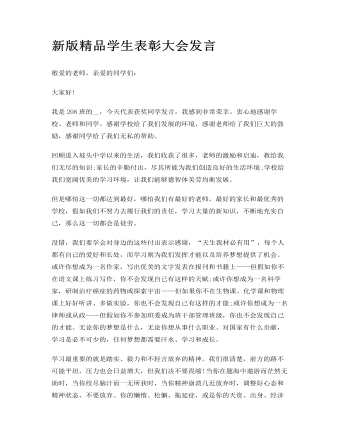
新版精品学生表彰大会发言
在这里,我也要和同学们说一说,我们来到学校的主要任务是读书、学习。我们为什么要读书、学习呢?以前我也不很清楚,现在,我知道了:读书是为了打好文化基础,提高自己的学习能力,掌握一定的本领,将来好为国家做出贡献,从而实现自己的人生价值。那么,怎样才能提高自己的学习成绩呢?我认为,首先要有勤奋学习的态度。只要你勤奋努力了,成绩就一定会慢慢提高,成绩提高了,你就会找到自信心,有了自信心,成绩就会提高的更快,到那时,你就会感到学习也是一件很快乐的事情。第二,要有正确的学习方法。我从一本书上看到一位清华大学的学生介绍的“三先三后”的学习方法,即先预习,后听课;先复习,后做作业;先独立思考,后请教别人。这种方法,我感到对我很有用。我就是这样学习的。我还听老师说过,一流高手做作业是看得懂,做得对,说得清。我现在正朝着这个方向努力着。第三、注意培养自己良好的学习习惯。主要有提前预习的习惯、专心听讲的习惯、及时改错的习惯、查找资料的习惯、勤于动笔的习惯、认真书写的习惯。
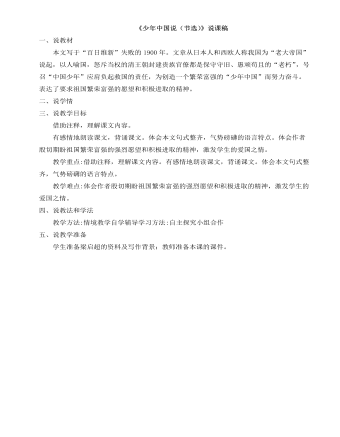
部编人教版五年级上册《少年中国说(节选)》说课稿
一、说教材本文写于“百日维新”失败的1900年。文章从日本人和西欧人称我国为“老大帝国”说起,以人喻国,怒斥当权的清王朝封建贵族官僚都是保守守旧、愚顽苟且的“老朽”,号召“中国少年”应肩负起救国的责任,为创造一个繁荣富强的“少年中国”而努力奋斗。表达了要求祖国繁荣富强的愿望和积极进取的精神。二、说学情三、说教学目标
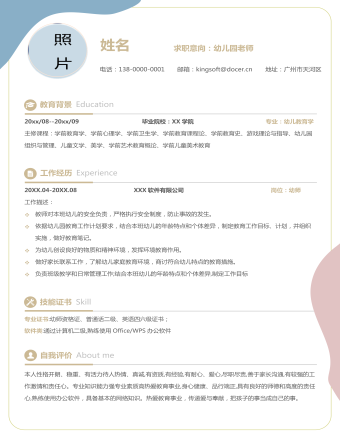
莫兰迪幼儿教师个人简历
20XX.04-20XX.08 XXX软件有限公司 岗位:幼师工作描述:v 教师对本班幼儿的安全负责,严格执行安全制度,防止事故的发生。v 依据幼儿园教育工作计划要求,结合本班幼儿的年龄特点和个体差异,制定教育工作目标、计划,并组织实施,做好教育笔记。v 为幼儿创设良好的物质和精神环境,发挥环境教育作用。v 做好家长联系工作,了解幼儿家庭教育环境,商讨符合幼儿特点的教育措施。v 负责班级教学和日常管理工作;结合本班幼儿的年龄特点和个体差异,制定工作目标。
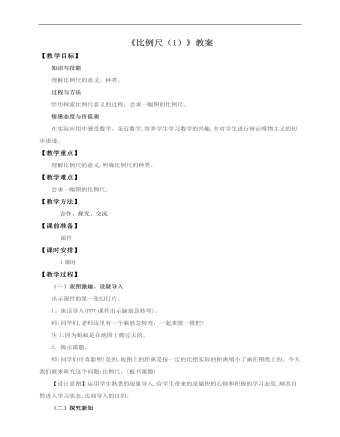
小学数学人教版六年级下册《第一课比例尺(1)》教案说课稿
(一)观图激趣、设疑导入 出示课件的第一张幻灯片。1、谈话导入(PPT课件出示脑筋急转弯)。师:同学们,老师这里有一个脑筋急转弯,一起来猜一猜把!生1:因为蚂蚁是在地图上爬过去的。2、揭示课题。师:同学们可真聪明!是的,地图上的距离是按一定的比把实际的距离缩小了画在图纸上的。今天我们就来研究这个问题:比例尺。(板书课题)【设计意图】运用学生熟悉的现象导入,给学生带来的是愉快的心情和积极的学习态度,顺其自然进入学习状态,达到导入的目的。(二)探究新知教学比例尺的意义及种类,理解比例尺的含义以及关系式。1、阅读教材第53页关于比例尺的内容。师:阅读教材后,汇报你知道了哪些关于比例尺的知识。生1:通过阅读我知道:一幅图的图上距离和实际距离的比,叫做这幅图的比例尺。图上距离∶实际距离=比例尺。(板书比例尺的意义)=比例尺生2:比例尺是绘图时用的,它是把实际距离按一定的比缩小或扩大,再画在图纸上。生3:教材介绍说,地图上的比例尺有1∶100000000,这是数值比例尺,它也可以写成这种形式,也叫数值比例尺。(板书)生4:老师,我看见这样表示比例尺的: 师:这叫线段比例尺。 它表示的是:图上1厘米的距离相当于地面上50 km的实际距离。(板书)生5:我会把上面的线段比例尺改成数值比例尺。图上距离∶实际距离。=1 cm∶50 km=1 cm∶5000000 cm(单位要相同)=1∶5000000(板书过程)生6:比例尺1∶5000000表示图上距离是实际距离的。实际距离是图上距离的5000000倍。
